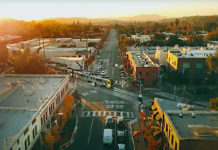The ongoing need to replenish the San Gabriel Valley aquifer in the aftermath of the drought continues to drive enormous spikes in water rates. The increases are coming in conjunction with new fiscal year budgets being adopted by regional water agencies facing ongoing uncertainty about future water supplies.
The Main San Gabriel Basin Watermaster, the San Gabriel Basin Water Quality Authority and the Upper San Gabriel Valley Municipal Water District, all of which levy water-related fees paid in part by South Pasadena residents, are implementing increases ranging between 20 percent and 33 percent.
Some but not all of the increases are already built in to the rates South Pasadena’s water division charges its approximately 6,100 customers. Those rates rose an average of 9 percent last year and will increase 7 percent June 1. There will be 6 percent average increases in each of the three following years. According to a 2017 study commissioned by the city, these increases will bring in an additional $9.1 million over the five-year period.
“The message to South Pasadena is we have to change our way of life,” city councilwoman Diana Mahmud told the South Pasadena News. “We have an uncertain water supply, and while there’s currently sufficient water in our local basin to meet our needs, there is no assurance that that water will be there next year or in the years beyond.”
A critical well used for planning purposes still hasn’t reached its target elevation, she noted. “Notwithstanding the abundant rainfall we had this year, we are still playing catchup for multiple years of drought.”
Here are some of the recent rate actions taken by San Gabriel Basin water agencies affecting what South Pasadenans pay for water:
- The Watermaster, which sets how much groundwater Valley pumpers can produce, approved its 2019-2020 budget May 1. The budget came to $4.71 million, up almost 6 percent from last year’s $4.45 million spending plan.
In connection with the budget, Watermaster went forward with its plan for steep increases in the annual Resource Development Assessment (RDA). The charge will rise 33.3 percent, from $105/acre-foot in FY 2018-19 to $140/AF for FY 2019-20. That’s on top of last year’s increase from $70 AF to $105/AF, and a planned increase to $175/AF next year.
According to its study, South Pasadena–which has four active wells that draw from the aquifer–is set to pay just under a quarter million dollars for its groundwater share of the RDA in FY 2019-20. And when combined with the Watermaster’s other pass-through for leased water and groundwater, the total bill will be over $1.25 million. In FY 2022-23, that figure is projected to be over $1.6 million.
Although the Governor formally declared the state-wide drought over in March 2017, this did not reflect conditions in the San Gabriel Valley. In March, the Watermaster warned basin producers of an ongoing, long-term critical water supply shortage in the Valley, and of the need to promote conservation measures.
In early May, Watermaster adopted the annual Operating Safe Yield, setting how much water can be pumped from the aquifer while maintaining an elevation above 200 feet at the Baldwin Park well used by regional water authorities as a planning indicator. Watermaster kept the OSY to a very low 150,000 AF during the drought, and in 2020-21 plans to lower it further to 130,000 AF for the next few years.
The Baldwin Park Key Well was at 195.6 feet May 27, well above the 169.4- foot historic low reached last November, but below the 233.5 pre-drought average.
- The Upper San Gabriel Valley Municipal Water District has set June 5 to adopt a 44 percent increase in its annual budget which includes a 25 percent increase in its annually renewed Water Availability/Standby charge. It plans to increase its budget from $27.42 million to $39.58 million, and to up the Standby charge from $8 to $10/acre (with a minimum of $10 for any parcel of one acre or less). The fee is collected on property tax bills.
The enormous budget increase is “a lingering effect of the drought,” District Executive Director Tom Love told the South Pasadena News, and is principally due to the need to buy more imported water to refill the aquifer. The District has already spent $11 million more on water purchases this year than it budgeted.
If approved, the revenue generated from the charge will increase from $1.65 million to $2.05 million. South Pasadenans will contribute roughly $9,500 to that.
- On May 22, the San Gabriel Basin Water Quality Authority, which is responsible for 31 groundwater treatment facilities in the basin, approved a new $43.2 million budget—a 9.4 percent decrease from last year’s $47.6 million. Despite the decrease, WQA set a hearing for Aug. 21 on a proposed 20 percent increase in the assessment it levies on water producers like South Pasadena.
The assessment would go from $10/AF to $12/AF and add nearly $400,000 to the current $1.98 million assessment. If approved, South Pasadena’s share would increase over $7,000 to $42,812.
WQA executive director Ken Manning gave two reasons for the increase. One is to preserve the agency’s reserve of just over $1.5 million. He also pointed to grant funds WQA gets from the state, a number of which require matches between 10 and 50 percent. “Since we haven’t received any federal funds over the last eight years,” the $2/AF increase is being made to replace the federal money. It is also unclear when or if the federal spigot will be restored.
South Pasadena water customers are projected to demand 3,400 AF per year. Roughly two-thirds of that will come from city wells. But charges associated with those pumping rights—from the Watermaster and WQA–are going up. Most of the rest of the demand is projected to come from leases whose terms are negotiated. Smaller portions are delivered directly or indirectly from the Metropolitan Water District, which added a 3 percent increase January 1 and will do so again next January 1; and the City of Pasadena, which adopted a new rate schedule set to take effect Aug. 1.
Meantime the Watermaster and other water agencies are working to ramp up their conservation outreach programs once again. This time, it will be on a “larger scale” with a more “regional message,” said Kelly Gardner, the Watermaster Assistant Executive Officer told San Gabriel Valley water officials May 14. The message is “the drought is not over,” and the plan is to get other watermasters involved—there are 15 in the South Coast hydrologic region.
Gardner told South Pasadena news Watermaster awarded a $200,000 contract to San Diego-based CityWorks to develop a program to reach beyond schools and social media in part by tying the message to weather reports. It wants to educate people about the fact that fully three-quarters of the water used in the San Gabriel Valley comes from groundwater–a much higher proportion than in neighboring watersheds such as Los Angeles—and the consequent heavy reliance on stormwater to refill the aquifer.
“There’s been one good year of rain,” she said, “but we’re not out of the woods yet.”




















.png)











First, local water authorities are also struggling with growing Calpers liabilities, which is driving part of their need for additional revenue. Public pensions lurk behind all of these discussions.
Second, see if you can spot the trend: Water from public agencies is becoming significantly more expensive, electric power from public agencies is becoming significantly more expensive, and we need an additional city sales tax — because property taxes, existing sales taxes, the library parcel tax, and the city utility tax aren’t enough to fund basic city operations.
The public sector in California has no capacity for controlling costs. Where does it end, and how?